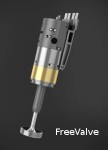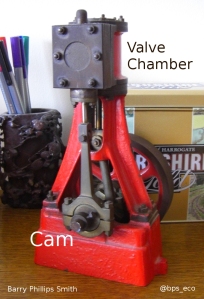End of the cam?
August 8, 2016
 I spotted an article recently about moving away from mechanical cam-driven valves on engines to computer controlled rapid acting “electro-hydraulic-pneumatic actuators” permitting far more precise control of valve movements without the “part open / part closed” stage of their mechanical counterparts. Why is this innovation important? Simple – it appears to offer a 16-17% improvement in fuel efficiency at a stroke – or to put it another way, a potential 16-17% reduction in CO2 emissions from transport (and any other engine-driven process) if it was adopted worldwide.
I spotted an article recently about moving away from mechanical cam-driven valves on engines to computer controlled rapid acting “electro-hydraulic-pneumatic actuators” permitting far more precise control of valve movements without the “part open / part closed” stage of their mechanical counterparts. Why is this innovation important? Simple – it appears to offer a 16-17% improvement in fuel efficiency at a stroke – or to put it another way, a potential 16-17% reduction in CO2 emissions from transport (and any other engine-driven process) if it was adopted worldwide.
 Which reminded me about “cams” and changing technology- especially as I have one on my desk as I write this! In my youth (well, for my Engineering Workshop Theory and Practice A-Level) I made a vertical D-slide double acting steam engine which uses a cam to control which side of the piston receives the steam, and which side is open to atmosphere. Because of this, the piston drives in both directions, rather than requiring the flywheel to drive the piston back to the top for older single-acting cylinders – at the time a major improvement in steam engine technology. And, in time, this very simple mechanical gizmo made its way into petrol & oil engines as a simple way to control valve movements, and now, for the first time in literally hundreds of years, we’re now seeing a step-change on the technology.
Which reminded me about “cams” and changing technology- especially as I have one on my desk as I write this! In my youth (well, for my Engineering Workshop Theory and Practice A-Level) I made a vertical D-slide double acting steam engine which uses a cam to control which side of the piston receives the steam, and which side is open to atmosphere. Because of this, the piston drives in both directions, rather than requiring the flywheel to drive the piston back to the top for older single-acting cylinders – at the time a major improvement in steam engine technology. And, in time, this very simple mechanical gizmo made its way into petrol & oil engines as a simple way to control valve movements, and now, for the first time in literally hundreds of years, we’re now seeing a step-change on the technology.
And made me wonder. Given that a move from a simple but commonly used mechanical system to a precise electronic system can radically alter the fuel consumption of the engines of potentially every car, lorry, bus, boat, ship … etc in use on the planet, where else could a bit of lateral thinking make big changes to our efficiencies, resource use, waste, and emissions whilst permitting us to continue to enjoy our tech-rich lifestyles?
You must be logged in to post a comment.